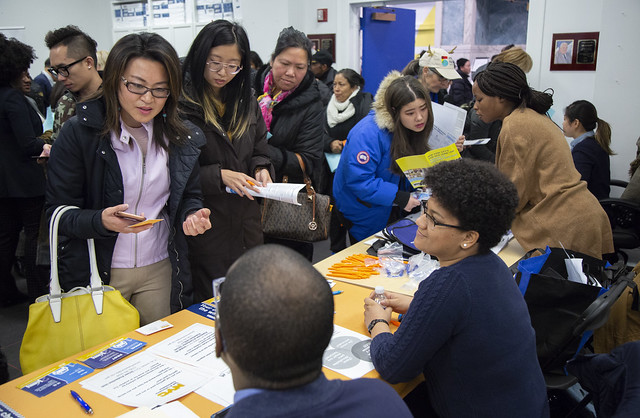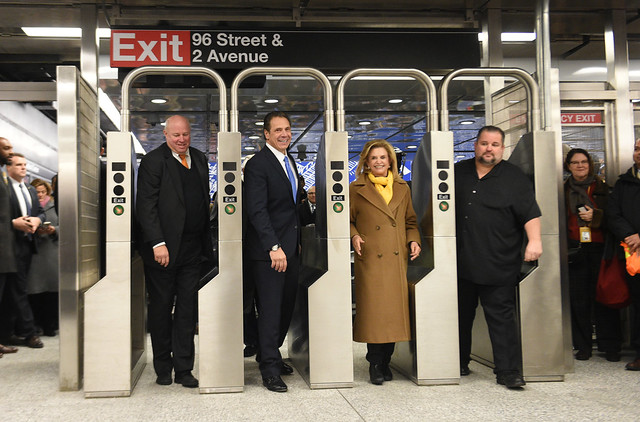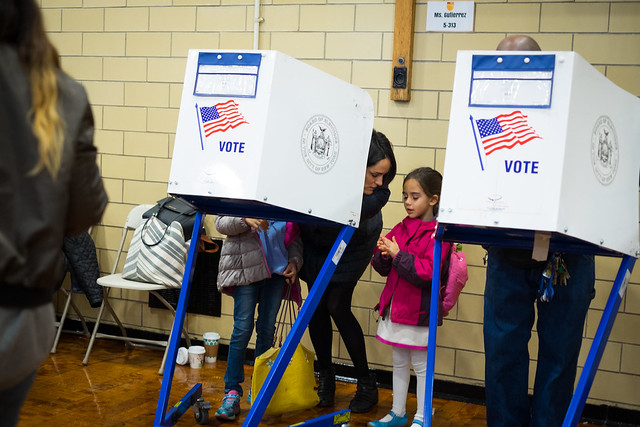Solving New York City’s Next Big Census Problem

(photo: John McCarten/City Council)
New Yorkers got some great news last week when President Trump abandoned plans to add a citizenship question to the 2020 Census. Adding the question to the Census would have resulted in a massive undercount of the city’s population, causing New York to lose its share of billions in federal funding for vital programs and services.
But there’s another wrinkle in this upcoming Census that could significantly depress participation across the city: the move to a digital Census. This will be the first-ever Census to be completed largely online. Though this change will be welcome news for many tech-savvy New Yorkers, it will bring new challenges in a city where 14 percent of residents live in households without a computer, 23 percent lack a broadband connection at home, and many more aren’t digitally proficient.
Just as city leaders stood up and fought the proposed inclusion of the citizenship question, New York City needs a wide-scale effort to make sure the move to a digital Census does not deter large numbers of New Yorkers from completing their forms. One way they can do this is by partnering in a big way with New York City’s branch libraries.
In recent years, libraries have extended far beyond their historical book-lending role to become the city’s most accessible technology hub for New Yorkers on the wrong side of the digital divide. In addition to providing computer stations, laptop loans, and free internet, they are also a place where those with limited tech literacy can get a helping hand from librarians.
Tens of thousands of New Yorkers already turn to branch libraries for tech help, whether it is applying to a job online, filling out Medicare applications, or simply staying in touch with family via email or Facebook.
Beyond having a substantial technology infrastructure, libraries have unparalleled reach: the city’s 216 branch libraries are on the ground in nearly every community across the five boroughs. Importantly, libraries are also one of the city’s most trusted institutions, providing a range of services in multiple languages but never asking for personal information.
All this makes libraries a natural fit to extend their services to help New Yorkers fill out the digital Census.
Right now, however, it’s not clear that the city’s libraries have the capacity to do this effectively. Many branches across the five boroughs don’t have laptops to loan, and most libraries have at most six or twelve computer terminals, barely enough to serve existing demand.
Beyond the need for more dedicated computers, laptops, and tablets, libraries will need additional staff to help the many patrons who require significant assistance completing the digital Census. At most branches today, librarians are already overextended.
To his great credit, Mayor de Blasio has already launched an outreach campaign to ensure an accurate Census count, and the recently passed city budget includes $40 million to support this effort. The de Blasio administration should devote a portion of those funds to the city’s libraries. Doing so would empower branches across the city to ramp up their capacity and harness their considerable potential to boost participation in the online Census.
***
Jonathan Bowles is executive director of the Center for an Urban Future, a think tank focused on expanding economic opportunity in New York. On Twitter @jbowlesnyc & @nycfuture.
***
Have an op-ed idea or submission for Gotham Gazette? Email This email address is being protected from spambots. You need JavaScript enabled to view it.
A French Lesson in Fare Evasion

(photo: Kevin P. Coughlin/Office of Governor Andrew M. Cuomo)
I just returned to New York City from a month in Paris, where my husband was doing legal work. A regular public transit user at home, I was the same in Paris, making use of its Metro system. But because I did not inform myself of all the rules, I violated one of them and had to pay a fine. The experience helped me think about the fare evasion challenge we’re dealing with in New York.
As in our subway system, there is one fare to travel throughout the city on the Paris Metro. I bought discounted “carnets” of 10 tickets at a time at a cost of about 14.90 euros, approximately $18. The tickets are small white cards; you put them in a slot on the way in, and if the ticket is valid it pops up in another slot to be retained; high plastic doors then open to let you through. When you leave the station at your stop, you walk through exits (sorties), which have high doors that open when you press on them with your hand.
Since there is no need to use the tickets to exit (they are needed at stations where you transfer to rail connections) and they are only good for one fare, I was throwing them away after entering a station. Of course this was silly of me; why wouId the entrance machines give you back the tickets if you weren’t supposed to keep them? But I wasn’t thinking it through and didn’t want to get used tickets mixed up with new ones from my carnets.
After a few weeks, while transferring between one train line and another at Gare St. Lazare, a major metro transfer point, I encountered a line of transit employees (they have orange vests like our MTA New York City Transit workers) stopping passengers walking through a tunnel. They asked to see my ticket.
In halting French with English mixed in I explained that I had thrown it away. Non, non madame, said one of the inspectors. You must retain your ticket. I shrugged, explained that I was a tourist, that I had been using the system for several weeks and no one had stopped me, and said I would go and buy a new ticket to present to the inspection team. Non, non madame, one of them said; you have to pay a fine right now.
She showed me a chart with different fines for different types of violations. I was shocked at how high they were. She ‘settled’ for a payment of 30 euros, about $35, whipped out a handheld charge machine, inserted my credit card and gave me a special receipt. The same thing was happening to people around me, who contended they had lost their tickets or didn’t have them for whatever reason.
At about the same time this happened to me in Paris, back home in Manhattan Governor Cuomo announced a comprehensive fare evasion deterrence program for the subways and buses, including the assignment of 500 personnel, including New York City and MTA police officers and 70 “Eagle Team” members, as well as a number of structural changes like securing emergency exits at subway stations and installation of video cameras.
Fare evasion has been a growing problem on New York City subways and buses in the last few years, according to the MTA. An MTA report issued in March estimated annual lost revenue due to fare evasion at $225 million in 2018; the projection for 2019 had grown to $260 million by the time of the governor’s June press conference.
The problem is particularly acute on buses where one of every five riders doesn’t pay the fare, the MTA says. It is infuriating to sit on a bus and watch others simply walk on without paying; drivers cannot be expected to take the risk of arguing with these passengers. But it is also a problem on the subways; I am sure everyone reading this column has seen people walking into stations through the emergency exit doors.
Stopping fare evasion should not be about criminalization or persecuting poor people—it’s about the money. Evasion hurts all transit riders by depriving the system of much-needed revenue and making the costs higher for those who do pay. $260 million a year is A LOT of money – enough, for example, to pay for half-fare Metrocards for all low-income riders eligible under the recently adopted “Fair Fares” initiative by the City Council and Mayor de Blasio. The worthy program should be fully implemented as quickly as possible and soon evaluated for possible expansion.
The heightened presence of law enforcement personnel and other initiatives to discourage fare evasion in the new plan are all worth trying, but they must be done carefully. And I suggest that, in addition, the MTA consider doing what the French are doing in the Paris Metro. It is not as big as New York’s system, of course, but does carry more than 4 million people a day and is the second busiest in Europe (after Moscow). It devotes 1,200 staff to fare evasion.
Instead of issuing summonses for non-payment that can be ignored with minimal – and no immediate – consequences, the Paris inspectors assess “penalty fares” that must be paid on the spot; 1 million of these penalties are issued a year in Paris.
New York City Transit, the MTA’s division that runs the subways and buses, should explore using the technology that Paris has employed to give members of the Eagle Teams who go onto buses to look for evaders hand-held devices that can check whether someone’s Metrocard (if they have one) has been used for that trip and if not, charge and collect a penalty fare, much higher than the regular fare but lower than the $100 civil fine for fare evasion. Do the same in the transfer tunnels in large subway stations like Penn and Grand Central.
Those who want to challenge the fine or cannot pay on the spot should have the option to pursue administrative appeals, but I strongly suspect this method will have more of a deterrent effect than simply issuing paper summonses to everyone. I certainly was very careful to save my Metro tickets after this happened to me!
***
Carol Kellermann was president of Citizens Budget Commission from 2008 through 2018.
***
Have an op-ed idea or submission for Gotham Gazette? Email This email address is being protected from spambots. You need JavaScript enabled to view it.
The Conspiracy in Queens is Beyond the DA Ballots

(photo: Edwin J. Torres/Mayoral Photo Office)
Election officials in Queens are counting ballots in the District Attorney Democratic primary recount exactly as the law prescribes -- and it is an injustice for Queens and an affront to democracy.
After a stunning reversal of fortune that saw Melinda Katz erase a 1,090-vote gap after absentee and other ballots were counted, Tiffany Cabán is challenging the rejection of a small number of provisional ballots that she thinks will turn the tide back in her favor. While there are many reasons a ballot could be rejected, the main cause at play here is that voters were not properly registered with the Democratic Party in time to vote in the June 25 primary.
Some are enrolled in a different party or no party at all, while others just didn’t enroll at their current address within the six-month window required by our state before this vote. Whatever the reason, many Queens residents came to the polls to vote in an important election and were told that their voice was not welcome.
New York, unlike most other big cities in the country, uses a closed primary system to determine who will be on the general election ballot. This means that only voters who are properly enrolled in a political party may vote in a taxpayer-funded partisan primary. The winner of each partisan primary, or the party nominee if there is only one candidate, then advances to a general election open to all registered voters.
In a city where Democrats represent nearly 70% of the electorate, this means that the relatively few people who show up and are allowed to vote in a Democratic primary essentially choose the winner of the general election.
The Republican nominee for Queens District Attorney has all but acknowledged the fruitlessness of trying to win, openly admitting he had not decided whether he would even bother to campaign for the office. The most likely outcome no matter if Katz or Cabán prevails in the primary recount, is that a county of nearly 2.4 million people will be represented by a District Attorney who received the support of barely 4% of registered Queens Democrats.
In a democracy, residents are supposed to choose their elected officials. In New York, politicians from both the Republican and Democratic parties have worked hard to turn that idea on its head and pick their constituents. New York’s ballot access rules are among the most restrictive in the nation and the results speak for themselves -- apathetic voters who can’t be bothered to engage in a system that makes it hard to participate and where they do not feel that their vote really matters.
Open primaries allow all registered voters to vote in a primary where all candidates for office are grouped together regardless of party affiliation. If no candidate receives 50% of the vote, the top two then face off in a general election, even if they are from the same party. It’s a system based on encouraging democracy.
Open primaries also allow new candidates from nontraditional backgrounds to break into the system. In the current structure, voters often avoid casting a ballot for candidates outside of the traditional parties for fear of spoiling the election in favor of someone they truly dislike. Traditional parties have intentionally perpetuated this dilemma to keep new players out and keep a broken system and the privileges that come with it in place.
Opening up primaries to all voters, regardless of party affiliation, gives candidates a reason to appeal to a broad range of the electorate, while head-to-head general elections take the spoiler-effect out of the equation and free voters to vote for the candidate they like best.
The editorial boards have opined that there is no conspiracy at play by machine Democrats to steal the primary, and that the rules are being scrupulously followed. However, the proceedings in Queens show once again that the rules are the conspiracy. It is time to replace New York’s outdated, unjust system with something as open and inclusive as our residents deserve.
***
Michael Volpe is the Chair of the SAM Party of New York and former candidate for Lieutenant Governor on the SAM line. He is the former Mayor of the Village of Pelham. On Twitter @SAMforNY.
***
Have an op-ed idea or submission for Gotham Gazette? Email This email address is being protected from spambots. You need JavaScript enabled to view it.




